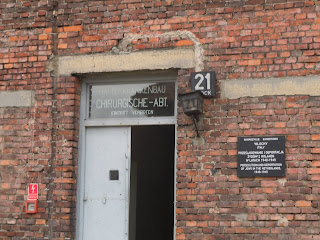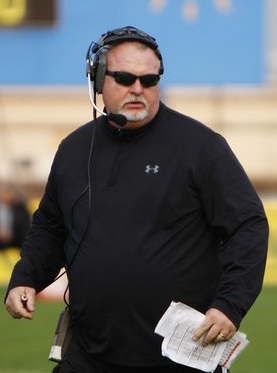
A Guard tower; overlooking the Auschwitz Death Camp.
After Germny invaded Poland (while expanding the Third Reich in search of Lebensraum) in 1939, Hitler ordered the Polish Army barracks near the village of Oświęcim, Poland turned into a concentration camp for political prisoners. The name of the town as well as the countryside was “Germanized” and will forever be associated with an overwhelming evil. It was called Auschwitz.

The "Arbeit Macht Frei" greeting on the front gate of Auschwitz.
Originally, the prisoners were Polish students, teachers, priests, and intellectuals that sought to resist the Nazi occupation of Poland. Anyone of influence that may organize resistance to the plans of the “Master Race” were rounded up and sent to Auschwitz. At first they were photographed, given numbers that were tattooed onto their bodies and records were kept of their existence. The average life span of an early prisoner of Auschwitz was three months. With a inhumanly demanding 11 hour work day of slave labor and a less that 1700 calorie daily diet of watery soup and moldy bread, the prisoners couldn’t last much longer. This in addition to the brutality and degradation they endured.
A flower inserted into the open gate at the entrance of Auschwitz. Brick barracks that originally housed Polish soldiers stand in the background.
In late 1941 and early 1942, the camp began mass extermination of Europe’s Jews as part of the “Final Solution” to the Jewish Question. There were other camps serving the maniacal state-sanctioned murder, but Auschwitz became the epicenter of evil and is conservatively associated with 1.5 million deaths. Of these, 400,000 Hungarian Jews were put to death in an 8-week period late in the war.

The barbed wire fence had 12 strands and was electrified with 6000 volts. There were two fences with a gravel zone between them. Of the millions imprisoned at Auschwitz, 144 successfully escaped.
To ease the overcrowding of the overflowing Auschwitz camp, a larger, more efficient death camp was built (entirely by slave labor from within the camps) three kilometers away. The Birkenau camp was 20 times larger and contained most of the infamous gas chambers and crematoriums. (An Auschwitz III was also built but completely destroyed at the end of the war.)

Each day, thousands of prisoners on their way to endure inhumane slave labor would have to walk past this area just inside the main gate. A band comprised of inmates was forced to play upbeat marching music as the prisoners left and staggered back into camp.
At the end of the war, with the Soviets approaching, the Nazis tried to cover up their crimes and made a hurried, unsuccessful attempt to destroy the Birkenau camp. Before marching the fittest prisoners westward toward Germany. The infamous gas chambers and crematoriums were blown up with the idea of bulldozing them and planting grass.. The ruins of the dreadful apparatus remain for viewing. As education and a reminder of the Santanya quote.

Quote in the entrance to the museum exhibits.
Today, I fulfilled a life-long desire to visit this place. To try to understand how an entire nation could follow the machinations of a madman and his henchmen. To understand how common, everyday folks could allow themselves to become the personification of evil for generations to come. How a nation could endorse and promote mass murder of a race of people because they were “undesirable”.
The combination of the two camps made up a somber first-hand learning experience. To pass under the “Arbeit Macht Frei” gate and walk past where a band of prisoners was forced to play rousing marching music as the inmates staggered to and from work. To pass by a wall designed for execution by firing squads To view a railroad rail attached to two posts to form a gallows for public hangings. To glimpse the blocks where the “Doctors” plied their horrible acts of “medicine”. To view two tons of hair, shorn from dead women. To stand in rooms where prisoners removed their clothes believing they were going to shower. To view the rooms where Zyclon B gas literally took thousands of lives in 20 minutes, and to try with trembling hands to photograph the brick and steel crematoriums where the victims were stacked 2 or 3 deep to burn. That was part of my day.
And as my feet got tired and I felt a pang of hunger late in the morning, I felt ashamed. When I cringed at the discomfort I felt as too many visitors surrounded and entered my “comfort zone” in the cramped hallways near the underground starvation cells, I felt ashamed. When my backpack became unwieldy and cumbersome, I thought of the mountains of luggage and possessions stolen by the SS and I felt ashamed. And after a three-hour tour through a literal man-made hell, I looked upward at the sun shining through the space in the roof of a wooden barracks, I told myself that I had seen enough and was ready to leave this place. And looking back on the memory of that instant, I will always be ashamed.
But when I encountered the exhibit of children’s toys and dolls taken from their young victims, I couldn’t force myself to look. How can the world that planned, condoned, allowed, and carried out this evil NOT be ashamed?
It has been said that a common saying that circulated around Birkenau was once you entered that famous gate, the only way you left was through the crematorium at the other end of the rail line a kilometer into the camp. As I envision the smoke from a million souls drifting heavenward and the ashes of a million souls spreading down the Vistula River, I desire that the world has the courage to never forget the overwhelming evil that man perpetrated on his fellow man. And holding in our memory the keys to never allow this to re-occur, may we too, never escape.
Lyn Hepner
Krackow, Poland
June 27, 2011

Open, used cans of Zyclon B. The gas used to exterminate untold hundreds of thousands. These are only a few of the ones that the Soviets found when they liberated the camp. Most had been disposed of by the Nazis by then.
Zyclon B in pellet form. It was poured into the vents of the gas chambers where it interacted with heat. The heat caused it to become deadly gas, killing as many a 2000 in one crowded chamber.


Literally, mountains of shoes, suitcases, glasses, razors, stolen from the prisoners by the Nazis. These pictures don't even begin to show the amounts found. The number on display pales horribly in comparison to what was sent back Germany in the 5 years of operation of the camps. The Nazis were experts at death and plunder.

Starvation cell. The name describes the fate of the prisoner.
As many as four prisoners were forced into these cells (about the size of a phone booth) and forced to stand for days. The door shown is at the bottom.

Blocks 19, 20, and 21 were reserved for the Camp "Doctors". Here, indescribable horrors were perpetrated on victims under the guise of medical science.

Just outside Block 11. Two posts between which prisoners were tied with their shoulders in such a way as to dislocate them forcibly.
Beside Block 11. A wall in front of which prisoners were shot.
Just above and to the right of the firing squad wall pictured above; they had to brick up the windows of the administrative offices above the courtyard. Of course, this was to protect those SS staff members working in those offices.
The windows below are inmate cells.
A railroad tie mounted on three posts. This served as a gallows for public hanging of attempted escapees. Fellow inmates were forced to watch, the grisly sight; sometimes standing at attention for 20 hours at a time .
After prisoners undressed, they were herded into this room. Air tight doors were shut and Zyclon B was released. In minutes, hundreds were dead.
The ovens. The pictures are not very good. I literally could not keep my hands from shaking.
Smoke stack emerging from the only remaining crematorium located in Auschwitz. Both the crematorium and the gas chamber are located underground.
This was constructed for the purpose of executing captured Camp Commandant Rudolf Hoess. It served its purpose in 1947. From these gallows, Hoess could have seen down the path thousands of Jews walked to their deaths.
These are a few of the pictures we took of Auschwitz. The Birkenau camp (3 km away) was 20 times larger and the site of infinitely more death and suffering. It was built entirely by slave inmate labor and is decaying rapidly. The ruins of the largest crematoriums and gas chambers are located at Birkenau.
Soon, I will post the pictures we took of this 16 square kilometer garden of death.
Just not today.
 The Birkenau Camp (Auschwitz II) was built alleviate overcrowding at Auschwitz and step up the horrendous task of eliminating Jews and other "undesirables" from the European continetnt. It was built entirely by prisoner slave-labor on a swamp area 3 km away. Consisting mostly wooden structures, it is in a state of decay and therefore, most of the exhibits from Birkenau are on display in the brick buildings of Aushwitz I. No visit to this epicenter of evil is complete without a visit to this camp.
The Birkenau Camp (Auschwitz II) was built alleviate overcrowding at Auschwitz and step up the horrendous task of eliminating Jews and other "undesirables" from the European continetnt. It was built entirely by prisoner slave-labor on a swamp area 3 km away. Consisting mostly wooden structures, it is in a state of decay and therefore, most of the exhibits from Birkenau are on display in the brick buildings of Aushwitz I. No visit to this epicenter of evil is complete without a visit to this camp.

